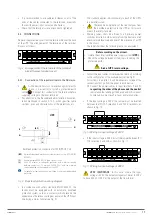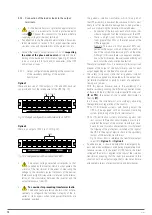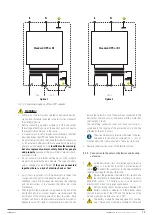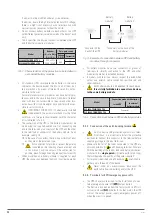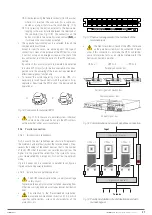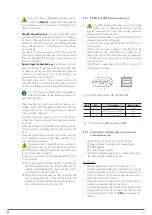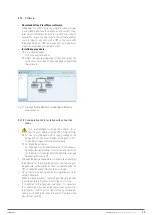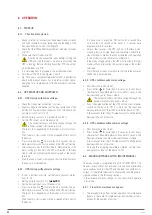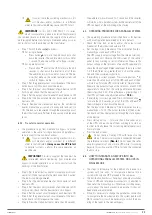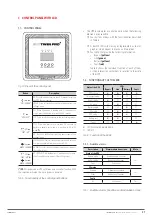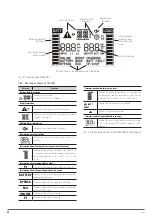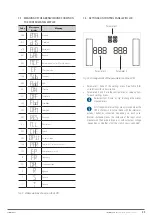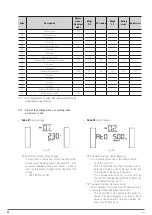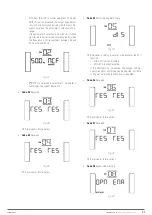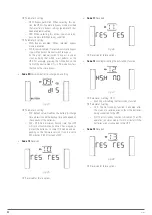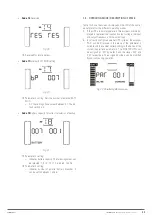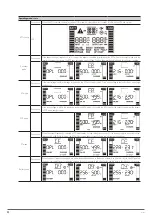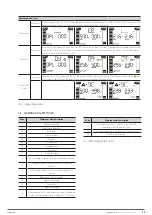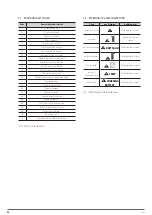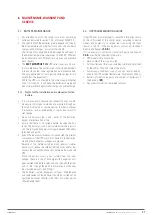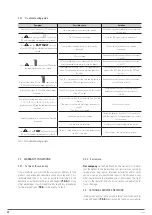
24
SALICRU
6. OPERATION.
6.1. STARTUP.
6.1.1. Checks before startup.
•
Make sure that all connections have been made correctly
and with sufficient torque, respecting the labelling of the
device and the instructions in Chapter 5.
•
Check that the UPS and battery module or modules switches
are ‘Off’.
•
Make sure that all loads are ‘Off’.
Shut down the connected loads before starting the
UPS and start the loads, one by one, only when the
UPS is running. Before shutting down the UPS, check that
all of the loads are ‘Off’.
•
It is very important to proceed in the established order.
•
For views of the UPS, see Figures 1 and 2.
•
Fig. 19 shows a conceptual representation of a distribution
board with manual bypass for a parallel system, repre-
sentative for a single device, with the number of switches
adapted.
6.2. UPS STARTUP AND SHUTDOWN.
6.2.1. UPS startup with mains voltage.
•
Check that the power connection is correct.
•
Supply voltage to the device (set the input protection of the
distribution board or manual bypass to ‘On’). If the board has
an output switch, set it to ‘On’.
•
Set the battery switch to ‘On’ (models B0 and B1).
•
Set the UPS’s input circuit breaker to ‘On’.
The output terminals will have voltage through the
device’s internal static bypass block.
The fan or fans, depending on the model, will start to func-
tion.
Then the main start screen will be displayed after a test of
the device.
•
Press startup button for more than 0.5 seconds, the au-
dible alarm will sound for 1 second and the UPS will start up.
•
After a few seconds, the UPS will be in ‘Normal mode’. If the
mains voltage is incorrect, the UPS will switch to ‘Battery
mode’, without interrupting the power supply at the output
terminals.
•
Start the load or loads, making sure that the rated power of
the device is not exceeded.
6.2.2. UPS startup without mains voltage.
•
If it has a distribution board, set the input and output protec-
tions to ‘On’.
•
Set the battery switch to ‘On’
(model B1)
.
•
Set the device’s input circuit breaker to ‘On’.
•
Press startup button for more than 0.5 seconds, the au-
dible alarm will sound for 1 second and the UPS will start up.
The fan or fans, depending on the model, will start to func-
tion.
Then the main start screen will be displayed after a test of
the device.
It is necessary to press the ‘ON’ button for a second time
for more than 0.5 seconds after about 5.. 7 seconds have
elapsed since the first press.
•
After a few seconds, the UPS will be in ‘Battery mode’,
meaning that its charge level and therefore available re-
sidual backup, as well as the risks associated with operating
in this mode, must be taken into consideration.
If the mains voltage returns, the UPS will transfer to ‘Normal
mode’ without interrupting the power supply at the output
terminals.
•
Start the load or loads, making sure that the rated power of
the device is not exceeded.
6.2.3. UPS shutdown with mains voltage.
•
Shut down the load or loads.
•
Press button for more than 0.5 seconds to shut down
the inverter. The audible alarm will sound for 1 second. The
device will be set to ‘Bypass mode’.
The output terminals will have voltage through the
device’s internal static bypass block.
•
To cut the output voltage of the UPS, set the circuit breaker
switch on the back to ‘Off’ or simply set the input and
output protections of the UPS’s distribution board to ‘Off’.
A few seconds later, the LCD screen turns off and the entire
device will be out of service.
6.2.4. UPS shutdown without mains voltage.
•
Shut down the load or loads.
•
Press button for more than 0.5 seconds to shut down
the inverter. The audible alarm will sound for 1 second. The
device will leave the output terminals without voltage.
A few seconds later, the LCD screen turns off and the entire
device will be out of service.
•
To leave the assembly completely isolated, set the input
and output switches of the board to ‘Off’.
6.3. MANUAL BYPASS SWITCH (MAINTENANCE).
The manual bypass integrated into all SLC TWIN PRO2 T UL
devices is very useful, but improper use can have irreversible
consequences both for the UPS and the loads connected to its
output. It is therefore important to observe the switching opera-
tions described in the following sections.
In the absence of mains voltage, it is not possible to operate
in this mode.
6.3.1. Transfer to maintenance bypass.
•
The procedure to go from normal operation to maintenance
bypass is the same for single devices and parallel systems,
except for the number of actions:








